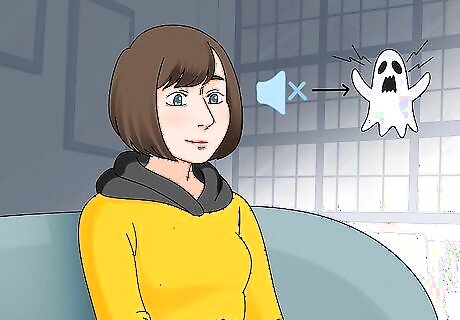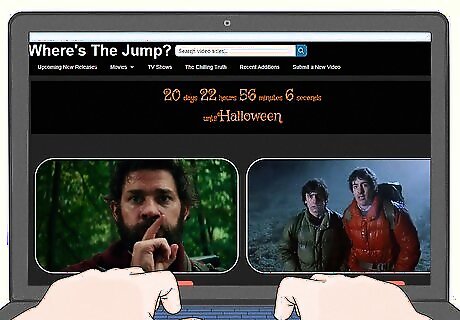
views
Anticipating Jump Scares

Relax -- know that the jumps are coming without worrying about them. Paradoxically, just knowing when a jump scare will likely occur may make you more likely to jump. That's because people start to fixate on the idea of the scare coming up, giving it their full attention as their fear mounts. But this is what a horror director wants -- you are focusing on the fear, just like the characters. When the jump eventually surprises you, you are so tuned into the moment that the scare hits you with twice the power. Try not to let the fear of an upcoming jump scare bother you -- just tell yourself that one is coming and stop worrying about it. The following steps detail ways to see jump scares coming, helping you anticipate scare. Instead of watching for these signals with dread, think like a filmmaker -- ask "how do these effects work to build tension", and not "when does the tension finally release?"

Be ready for at least one jump scare within the first 30 minutes. This may seem like a broad assertion, but it stems from the larger artistic reason to use jump scares in a film. Horror is a genre that manipulates fear and tension, trying to grow this fear slowly throughout the movie so it all culminates in one big scare or set piece (like the reveal of the monster). To do so, directors use small scares to get your adrenaline pumping. This puts you in frazzled, tense state, which makes more complex or psychological scares easier to pull off later on. Think of each jump scare as a horror director's early "brush strokes" and you'll be better equipped to handle them.

Know the audio cues commonly set before a jump scare. Silence is the most common, but it usually comes right after a long, slow, and ominous swell in the music. Remember that jump scare work by hitting you with an image or sound very abruptly and quickly, not by slowly ratcheting things up. Thus a scare almost always comes right after a lull or moment of quiet -- this makes the loudness of the scare extra noticeable and frightening.

Keep an eye on unnaturally empty spaces in the frame. If a character is leaning in the bottom of the screen and there is a big space of blackness or an empty room behind them, be ready for that frame to fill. The director is knowingly drawing your eye to that space and hoping that you'll dread the idea of it getting filled. Instead of sitting and waiting for the jump to occur, recognize that they are simply moving your eye to the place they are about to scare you. It's the oldest trick in horror cinematography -- but an easy on to see. Note that some modern directors are adept at keeping the screen blank the first few times to lull you into a false sense of security.

Be aware immediately after any "false" scares. A cheap but common trick is to ramp up the music and suspense before a dramatic moment (like opening a dark hallway door), then show absolutely nothing scary. More often than not, this moment of relaxation is simply used to lull you into a false sense of security -- the real scare is coming shortly afterward. Any scene that spends its time building or establishing tension will try and pay off in some way -- rarely do directors put you on the edge of your seat but give you nothing to "do" once you get there. Be on the lookout for this rising tension.

Watch more and more horror movies to get desensitize the urge to jump. The best way to get over jumping during horror movies is to jump a lot during horror movies. The more horror you know and see, the less likely it is that any particular movie or moment will be able to scare you. Horror has a lot of great qualities, but plot originality is not frequently one of them. The more you know, the more you'll be able to successfully anticipate. Horror or thrilling video games are a great way to get used to jump scares as well, because they require you to not only react but also do something with your reaction (like shoot the bad guy) that helps you learn to stay calm.

Check out a site like WheresTheJump.com for a comprehensive list of jump scares. While they don't have every movie ever, they feature just about every movie you could want to watch. Furthermore, they have ratings on how "jump-heavy" each movie is, and some films have subtitle files that you can download that will warn you 2-3 seconds before a jump scare is coming. While it may sound like overkill, it is one of the best ways to completely avoid jumping.
Watching Horror More Confidently

Recognize common formula used in 99% of horror films to get past the tension in them. Horror movies are a particularly formulaic genre, as anyone who has watched a lot of horror can attest. This means, however, that astute viewers can usually piece together the general arc of action and suspense. While this may "ruin" the scares a bit, it helps you realize that the scares in horror aren't real -- they are manufactured in a very similar way to get a very similar response from all viewers: First is a scene meant to scare you immediately, such as the first victim or the release of the "evil" at the heart of the film. Second comes establishment of characters and locations. This is usually the place of the first jump scare -- not the real villain or scare, but something to put you on edge. Third comes the first death or scare, while people think things are still "normal" in the horror world. The jump scare usually coincides with this death, if there is one. Fourth comes the worst/scariest part of the film -- the bodies mount up and the characters slowly realize that things are not looking good. Expect 1-2 more jump scares. Fifth and finally comes the defeat of the villain (or is it?!), and this section is usually more action-heavy than the rest. There may be 1-2 jump scares, but they are usually easy to see coming.

Watch horror films with an eye for style over substance. Because most horror films follow cookie-cutter plots, this isn't where most directors look for inspiration or originality. Horror is a very stylized, unrealistic genre that takes great creative leaps in lighting, costume design, sound/music, and theme in order to stay relevant. Most horror connoisseurs don't watch horror to get scared all of the time, they watch it to enjoy great artists pushing an extreme and stylish genre to its limits, all while serving up a delicious shot of adrenaline. Cinematography in horror films is extreme and artistic. Pay attention to the lights and common colors, crazy camera angles, and interesting jumps or cuts. Social themes are common motifs in horror, exploring what society fears through art. From Night of the Living Dead to It Follows, look for the real-life metaphors. Sound and Music are subtle but key. It's been shown that sound on its own is often scarier than pure visuals. Anyone who's ever been alone at night in a creaky house knows that, but ask yourself how the filmmakers are able to pull off this same effect in the movie.

Remember that the best horror movies are the ones that subvert, not conform, to your expectations. A truly great horror movie is scary because you never see the events and scares coming. While all horror films will follow the "rules" outlined above to various degrees, you should be prepared for a great horror flick to break these rules in crucial, terrifying ways. The best way to avoid jumping, at the end of the day, is to never watch horror movies in the first place. But what is the fun in that?!

Know that your jumping or flinching is an evolutionary advantage worth keeping around. You may get annoyed at how easily you flinch during a jump scare, even one that you see coming, but there is a very good reason for the jump. Almost all mammals share this "startle reflex," as it naturally moves you away from potential danger without having to take the time to think of it. Even if it's not fun, it is hardwired into human DNA to move when scared.


















Comments
0 comment